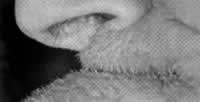Right_Box_Heading2
Paragraph_Content Add_More_Link
Periodontal
Gum tissue disease has been linked to other diseases of the body. The health of the gum tissue can affect the health of the heart, lungs, pancreas and other body organs.
There is nothing that frustrates and saddens a dentist quite as much as the following fact:
The primary reason dentures are ever necessary is because of periodontal disease (commonly known as pyorrhea) – despite the fact that this common destroyer is caused by factors that are understandable, treatable and invariably controllable.
In other words, the common idea that loss of teeth is inevitable as we age simply is not true.
LET’S EXPLORE FURTHER
What does periodontal disease do?

This is what it can do!!

This is what it did to a 38-year-old woman.
As you know, the prefix perio means around. Therefore, periodontal disease refers primarily to soft tissue and bone destruction around the teeth. When a tooth loses its bone support, trouble follows. That tooth is no longer a strong, functional tooth.
Periodontal disease is caused by bacterial plaque. Plaque is the nearly invisible coating that continually forms on the teeth. Ben Franklin called it “tooth fur”. When the plaque is not completely removed once in every 24-hours period, it causes inflammation of the tissue—which leads to periodontal disease.
A primary symptom of periodontal disease is inflammation with varying degrees of bleeding, but the great danger lies in the accompanying damage to the underlying bone. Perhaps the reason so many people become careless and, therefore, victims of this common disease is that they cannot actually see the underlying bone destruction occurring.

Shown above are the upper and lower jaws of a Neanderthal man who lived 40,000 years ago. He, too, was a victim of periodontal disease. You can easily see the irregular remaining bone area. (The broken lines show where the bone level should be.) This early man was not aware that the underlying bone was being destroyed. Even if he had had a mirror, he could not have seen the bone destruction happening because of the presence of the covering gum tissue. About all he knew was that he had sore gums that bled regularly and that he had food catches. You can be certain that because of the infection present, he also had halitosis.


A
B
Shown above is a front tooth (A-arrow) that has lost most of its supporting bone. The dentist removed the tooth (B) with his fingers. No instruments were required. The patient was 40 years of age.
Our aim is to help you understand how it all happens so it will not happen to you. It has been estimated that 90% of all Americans over the age of 35 are afflicted to some degree.
How does it happen?
 Bacterial plaque is the great bone destroyer and tooth killer.
It is particularly dangerous because of its presence in the
gum crevice. If the bacterial plaque is not removed daily,
the toxins stay in contact with the surrounding tissue causing
inflammation and swelling. The gums begin to bleed.
Bacterial plaque is the great bone destroyer and tooth killer.
It is particularly dangerous because of its presence in the
gum crevice. If the bacterial plaque is not removed daily,
the toxins stay in contact with the surrounding tissue causing
inflammation and swelling. The gums begin to bleed.
![]()
 The inflammation continues; the bacterial activity begins
to spread. Packets begin to form between the teeth and the
gum tissue. (See explanation of periodontal
pocket earlier in this section) These pockets create
room for even more bacterial activity. A vicious cycle
is created.
The inflammation continues; the bacterial activity begins
to spread. Packets begin to form between the teeth and the
gum tissue. (See explanation of periodontal
pocket earlier in this section) These pockets create
room for even more bacterial activity. A vicious cycle
is created.
![]()
 The old-fashioned word “pyorrhea” means “pus
flow”. The characteristic pus formation follows the bone
infection. Bone destruction follows. The patient is usually
not aware of any problem.
The old-fashioned word “pyorrhea” means “pus
flow”. The characteristic pus formation follows the bone
infection. Bone destruction follows. The patient is usually
not aware of any problem.
![]()
 As the bone is destroyed (this is a relentless process),
the teeth become loose. Remember the fence post: If only one-third
of the post remains in the ground, it is no longer a solid
post. The same is true for teeth.
As the bone is destroyed (this is a relentless process),
the teeth become loose. Remember the fence post: If only one-third
of the post remains in the ground, it is no longer a solid
post. The same is true for teeth.
![]()
It is possible for periodontal disease to destroy an entire mouth and have no decay present in that mouth.


